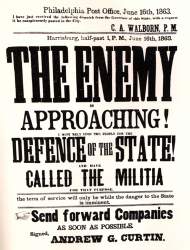Battle of Gettysburg (Garraty, 1994)
Textbook
A month after the battle of Chancellorsville, Lee again invaded the North. He still hoped that a decisive victory on northern soil would cause the United States to give up the struggle…For two days the battle raged. As the sun set on the second day, Union troops still held a steep knoll called Little Round Top. From there they cut the Rebel rank to ribbons. That night Lee made the fateful decision to charge the center of Meade's line. The same night a few miles away, Meade planned for an attack on his center. He moved his strength there. The afternoon of July 3 proved him right. Between one and two o'clock, while Confederate artillery pounded Cemetery Ridge, General George E. Pickett led a charge at the Union position. Howling the eerie "rebel yell," 15,000 infantrymen started to trot across the open ground. For a brief moment some of these confederates reached the Union trenches on Cemetery Ridge. But Union reserves counterattacked quickly. Pickett's surviving men were driven off...The battle was over. Lee retreated back into Virginia.
John A. Garraty, The Story of America (Austin: Holt, Rinehart, and Winston, 1994), 574.



























































































